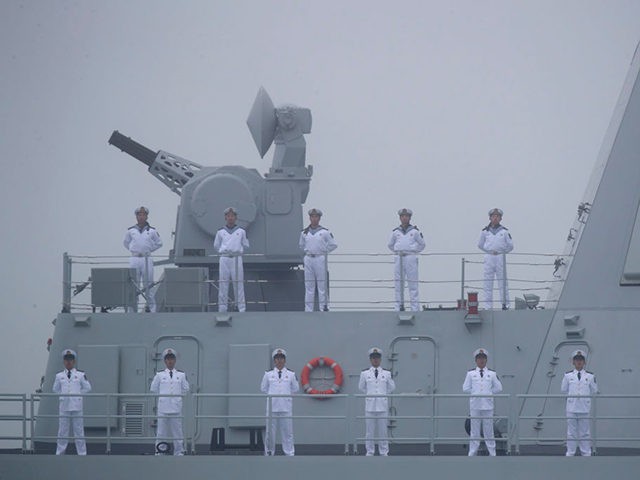The Chinese People’s Liberation Army (PLA) will begin military exercises in the South China Sea — which China illegally claims is entirely within its territory — on Monday, in a move Chinese social media framed as a message to the administration of U.S. President Joe Biden.
China’s claims in the South China Sea span over the sovereign territory of five countries: Vietnam, Malaysia, Brunei, the Philippines, and Taiwan. The government of the Philippines sued China at the Permanent Court of Arbitration at the Hague, a venue open only to state claimants, and received a favorable ruling in 2016 which affirmed the illegality of Beijing’s claims. China has since openly vowed to defy the ruling and the Philippines, under a new presidential administration, has done little to challenge China’s continued presence in its waters.
Recent satellite images suggest China has embarked upon further illegal construction operations in parts of Vietnam and the Philippines throughout the time of the Chinese coronavirus pandemic, when the territorial dispute had largely disappeared from news headlines.
The state-run Global Times newspaper announced the month-long military drills in the sea on Sunday and framed them as a message to Washington, more than one to Manila or Hanoi. The Chinese military will ban all non-PLA ships from entering the territory used for the drill for the entire month of March.
“The exercises come at a time when the US has started to again frequently conduct close-up reconnaissance operations on China’s coastal regions as well as on hydrological environments in the South China Sea,” the Global Times noted. The U.S. Navy has regularly conducted what are known as “Freedom of Navigation Operations” (FONOPs) in the South China Sea for years, meant to challenge the idea that the territory in question is exclusively Chinese. The FONOPs are conducted openly and legally.
The Global Times appeared to take issue not with the FONOPs, but with alleged “reconnaissance” exercises by both the United States and France, accusing them of “eavesdropping” on the PLA. The newspaper concluded, citing Communist Party-approved “experts,” that China should “enhance combat preparedness” to confront the U.S. military.
Perhaps in response to China’s announcement, Taiwan — a sovereign state that China claims illegally as a rogue province — announced live-fire exercises in the South China Sea on Monday. Focus Taiwan noted that the country had enhanced its military exercises and increased the presence of its Coast Guard in disputed territory in response to growing numbers of illegal Chinese aircraft excursions into Taiwanese airspace since the inauguration of President Joe Biden.
“The drills are being staged amid almost daily flights by Chinese military aircraft into airspace around Taiwan, in particular in the southwest part of Taiwan’s Air Defense Identification Zone (ADIZ) near the Pratas Islands in recent months,” Focus Taiwan noted.
Chinese activity in the sovereign territory of Taiwan has also recently caused alarm. The South China Sea Chronicle Initiative (SCSCI), a non-governmental organization (NGO), published images last week of what appeared to be a surface-to-air missile base built by the Chinese on an island close to Vietnamese waters. Similar images found ongoing illegal Chinese construction in the Philippines in the past year.
For years, while the Philippines and China litigated at the Permanent Court of Arbitration, Chinese engineers built artificial islands on reefs in the Spratly and Paracel Islands, legally part of Vietnam and the Philippines. Satellite images of those artificial islands appear to show missiles, surveillance technology, and other military assets placed in the territory. Beijing has responded to global criticism of its development in the territory of other countries by claiming that it has only placed civilian assets on those artificial islands and that they are meant for “search and rescue” operations as well as for monitoring the weather.
Environmentalists have for years decried China’s construction in the region, noting that the delicate reef ecosystems there could not have survived being buried by dredging. China had destroyed at least 17 major reefs in the region by 2015, according to the Philippine government.
“China occupies seven reefs in the Spratlys. It is reclaiming on all seven reefs. Although it occupies seven reefs, it is using filling materials from 10 other reefs so China has actually destroyed 17 reefs in total,” Philippine Supreme Court Senior Associate Justice Antonio Carpio revealed that year.
Construction and overfishing by Chinese ships — which do not have the legal authority to be in much of the territory they have exploited — have exacerbated the environmental destruction. In addition to overfishing in the region, Chinese ships have repeatedly harassed and attacked Vietnamese and Filipino vessels present in these territories legally.
“If you built something, if you’ve put dirt, rubble, and pavement [on top of coral reefs] … There’s no way to recover that,” John McManus, a professor of marine biology at the University of Miami in Florida, told Radio Free Asia (RFA) in October.
Experts have lamented that, prior to China’s construction, the Spratly Island region was one of the world’s richest fishing deposits.

COMMENTS
Please let us know if you're having issues with commenting.